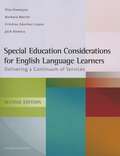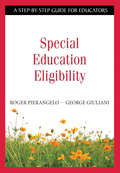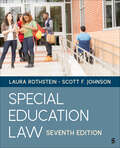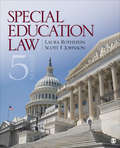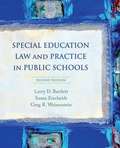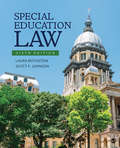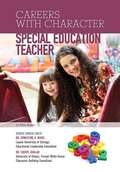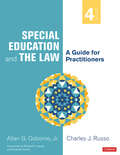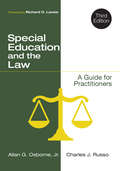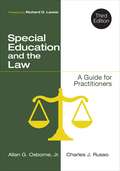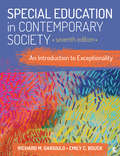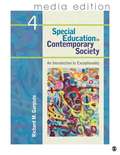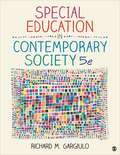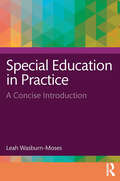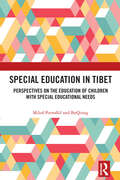- Table View
- List View
Special Education Considerations for English Language Learners: Delivering a Continuum of Services
by Else Hamayan Jack Damico Barbara MarlerThis important guide shows how to determine appropriate interventions for ELLs with academic challenges. It includes extensive new discussions of RtI and standardized testing used for diagnostic purposes and and reviews consequences for ELLs. The ensuring a continuum of services model featured in the book is a strong collaborative framework that takes teams of educators step-by-step through gathering information about and implementing effective interventions for ELLs with learning difficulties.
Special Education Eligibility: A Step-by-Step Guide for Educators
by Roger Pierangelo George A. GiulianiOffers clear guidelines aligned with the reauthorization of IDEA 2004 for assessing students' eligibility for special education services and for working with families and service providers.
Special Education Law
by Laura F. Rothstein Scott F. JohnsonThe 7th Edition of Special Education Law, written by Laura Rothstein and Scott F. Johnson, provides a comprehensive and current overview of the major federal law, and judicial interpretations of those laws, that apply to special education students. School administrators and attorneys attend to special education issues on a regular basis, and local superintendents, principals, special education professionals, psychologists, and regional and state administrators must also be familiar with the legal requirements of educating students with disabilities. Classroom teachers of all types need to be aware of the laws that affect them and their students. Special Education Law 7e is intended for students in education and educational administration, both graduate and undergraduate, as well as law students in courses on special education law, school law, and special education. The framework of this book begins with five introductory chapters on the major issues that are addressed in special education law. These topics include an overview the legal system, the history of special education, major statutes in special education law, stakeholders such as students, families, educators, and advocates, and finally, requirements for protection under various special education laws. The remainder of the text presents and analyzes special education case law within specific contexts. The text helps educators understand what the law requires so that they can make decisions that comply with these laws. The 7th edition reflects major changes in judicial interpretation and education policy developments at the federal level since 2021, including the dramatic impact of the COVID pandemic on education generally and special education specifically, a new Supreme Court decision, and new references and examples throughout.
Special Education Law
by Laura F. Rothstein Scott F. JohnsonThe 7th Edition of Special Education Law, written by Laura Rothstein and Scott F. Johnson, provides a comprehensive and current overview of the major federal law, and judicial interpretations of those laws, that apply to special education students. School administrators and attorneys attend to special education issues on a regular basis, and local superintendents, principals, special education professionals, psychologists, and regional and state administrators must also be familiar with the legal requirements of educating students with disabilities. Classroom teachers of all types need to be aware of the laws that affect them and their students. Special Education Law 7e is intended for students in education and educational administration, both graduate and undergraduate, as well as law students in courses on special education law, school law, and special education. The framework of this book begins with five introductory chapters on the major issues that are addressed in special education law. These topics include an overview the legal system, the history of special education, major statutes in special education law, stakeholders such as students, families, educators, and advocates, and finally, requirements for protection under various special education laws. The remainder of the text presents and analyzes special education case law within specific contexts. The text helps educators understand what the law requires so that they can make decisions that comply with these laws. The 7th edition reflects major changes in judicial interpretation and education policy developments at the federal level since 2021, including the dramatic impact of the COVID pandemic on education generally and special education specifically, a new Supreme Court decision, and new references and examples throughout.
Special Education Law
by Scott F. Johnson Professor Laura F. RothsteinSpecial Education Law, Fifth Edition provides a comprehensive, and student-friendly overview of the major federal laws—and judicial interpretations of those laws—that apply to the education of children with special needs. Laura Rothstein and Scott F. Johnson thoroughly present the most up-to-date information on special education statutes, regulations, and judicial interpretations, including substantial changes in the interpretation of the legistlation. The text helps students understand what the law requires so that they can develop policies and make decisions that comply with these laws.
Special Education Law and Practice in Public Schools
by Larry D. Bartlett Greg R. Weisenstein Susan EtscheidtA must have resource for school leaders and personnel, Special Education Law and Practice in Public Schools is dedicated to understanding the complex laws and issues surrounding students with special needs. Broad in coverage, it discusses current topics such as: the reauthorization of IDEA, NCLB, and 504; working with families; IEPs; assessment; staff relationships and staffing patters; due process hearing, mediation and complaints; school-wide discipline, and strategies for specific populations ( infant/toddler, preschool, secondary school, etc. ) Filled with ready-to-use samples and inclusion strategies, the book adheres to school administration and CEC standards and is a conclusive resource for practicing professionals.
Special Education Law: Cases and Materials
by Mark C. Weber Ralph Mawdsley Sarah RedfieldThis book contains relevant statutory excerpts and carefully edited reports of the leading special education cases, together with extensive explanatory materials and provocative questions for class discussion. <p><p> The book also features practical exercises for home assignments or in-class projects. Two of the co-authors teach in law schools and have deep experience in special education law as well as allied subjects such as constitutional law, administrative law, civil procedure, federal courts, and general school law. Their background enables them to discuss the special education topics thoroughly and to draw connections to other parts of the law school curriculum. The third co-author, who is also a lawyer, teaches educational administration as well as special education law; that background enables him to add lessons on the real-world impact of the law on the daily work of the schools. <p><p> The Fourth Edition includes new cases on eligibility, damages, and other topics, as well as coverage of the new Infant and Toddler Program regulations.
Special Education Law: Rothstein, Special Education Law, Fourth Edition + Osborne, Special Education And The Law: A Guide For Practitioners, Second Edition
by Scott F. Johnson Professor Laura F. RothsteinSpecial Education Law 6e, written by Laura Rothstein and Scott F. Johnson, provides a comprehensive and current overview of the major federal law, and judicial interpretations of those laws, that apply to special education students. School administrators and attorneys attend to special education issues on a regular basis, and local superintendents, principals, special education professionals, psychologists, and regional and state administrators must also be familiar with the legal requirements of educating students with disabilities. Classroom teachers in all types of classrooms need to be aware of the laws that affect them and their students. Special Education Law 6e is intended for students in education and educational administration, both graduate and undergraduate, as well as law students in courses on special education law, school law, and special education. The framework of this book begins with five introductory chapters on the major issues that are addressed in special education law. These topics include an overview the legal system, the history of special education, major statutes in special education law, stakeholders such as students, families, educators, and advocates, and finally, requirements for protection under various special education laws. The remainder of the text presents and analyzes special education case law within specific contexts. The text helps educators understand what the law requires so that they can make decisions that comply with these laws. Updates for the sixth edition include a major reorganization of the text. Chapters have been streamlined and edited for clarity, combining a previous chapter on Related Services with Free Appropriate Publication Education, and folding Eligibility into Identification, Evaluation, and Eligibility, so students can better see the connections between these topics. Many case excerpts have been shortened or summarized to provide students with a more straightforward and focused reading experience. The latest updates in statutes, regulations, and case law are included throughout the text.
Special Education Law: Rothstein, Special Education Law, Fourth Edition + Osborne, Special Education And The Law: A Guide For Practitioners, Second Edition
by Scott F. Johnson Professor Laura F. RothsteinSpecial Education Law 6e, written by Laura Rothstein and Scott F. Johnson, provides a comprehensive and current overview of the major federal law, and judicial interpretations of those laws, that apply to special education students. School administrators and attorneys attend to special education issues on a regular basis, and local superintendents, principals, special education professionals, psychologists, and regional and state administrators must also be familiar with the legal requirements of educating students with disabilities. Classroom teachers in all types of classrooms need to be aware of the laws that affect them and their students. Special Education Law 6e is intended for students in education and educational administration, both graduate and undergraduate, as well as law students in courses on special education law, school law, and special education. The framework of this book begins with five introductory chapters on the major issues that are addressed in special education law. These topics include an overview the legal system, the history of special education, major statutes in special education law, stakeholders such as students, families, educators, and advocates, and finally, requirements for protection under various special education laws. The remainder of the text presents and analyzes special education case law within specific contexts. The text helps educators understand what the law requires so that they can make decisions that comply with these laws. Updates for the sixth edition include a major reorganization of the text. Chapters have been streamlined and edited for clarity, combining a previous chapter on Related Services with Free Appropriate Publication Education, and folding Eligibility into Identification, Evaluation, and Eligibility, so students can better see the connections between these topics. Many case excerpts have been shortened or summarized to provide students with a more straightforward and focused reading experience. The latest updates in statutes, regulations, and case law are included throughout the text.
Special Education Teacher (Careers With Character #18)
by Ellyn SannaFind out what it takes to be a special education teacher with character... Special education teachers work with students who have one of these disabilities: *Speech or language impairments; *Mental retardation; *Emotional disturbance; *Learning disabilities; *Hearing impairments; *Visual impairments; *Autism; *Deaf-blindness; or *Multiple disabilities and other health impairments. If you think you might want to work with students who have disabilities like these, you'll need education and experience--but you will also need the qualities of a good character. Special education teachers with character have... The respect and compassion that will build children's self-esteem... The responsibility to teach students the skills they'll need to move toward independence... The courage to stand up for those who have often been rejected... And the diligence to keep going, one small step after another, so that one day students will look back and be amazed by how far they've come. Special education teachers make a difference in children's lives! This volume of Careers with Characters will show you how.
Special Education and Social Interests (Routledge Library Editions: Education)
by Len Barton Sally TomlinsonUntil this book was published, most writing on special education was about specific disabilities and how to cope with them. This book, however, considers the broader context, looking at many problems for the wider system that have arisen through integration of special education within it. The book is international and comparative in its focus and includes much North American material and work by North American researchers.
Special Education and the Law: A Guide for Practitioners
by Allan G. Osborne Charles RussoThe essential resource for success in special education Educators face major challenges when addressing the needs of students with disabilities. This includes understanding a complex legal field: special education law. Special Education and the Law, Fourth Edition: A Guide for Practitioners is the ultimate for busy educators. Osborne and Russo, past presidents of the Educational Law Association, are experts in translating legalese into language that educators can understand. They have created a resource that examines legislation and interprets the statutes and their regulations in a reader-friendly format. Major topics include rights of access to public education, procedural due process, placement requirements, delivery of related services, discipline of students with disabilities, and remedies for failure to adhere to the law. With a preventative approach to litigation that separates it from other publications, this book features: • Updates on legal developments from the almost-1000 federal and state cases decided since publication of the third edition in 2014 • Coverage of IDEA, ADA, FAPE, 504, discipline, IEPs, LRE, parental considerations, public vs. private school considerations, and attorney fees • A focus on federal and state interpretations With its user-friendly format, this resource will help educators focus on their core competency: providing exemplary education to students with special needs.
Special Education and the Law: A Guide for Practitioners
by Allan G. Osborne Charles RussoThe essential resource for success in special education Educators face major challenges when addressing the needs of students with disabilities. This includes understanding a complex legal field: special education law. Special Education and the Law, Fourth Edition: A Guide for Practitioners is the ultimate for busy educators. Osborne and Russo, past presidents of the Educational Law Association, are experts in translating legalese into language that educators can understand. They have created a resource that examines legislation and interprets the statutes and their regulations in a reader-friendly format. Major topics include rights of access to public education, procedural due process, placement requirements, delivery of related services, discipline of students with disabilities, and remedies for failure to adhere to the law. With a preventative approach to litigation that separates it from other publications, this book features: • Updates on legal developments from the almost-1000 federal and state cases decided since publication of the third edition in 2014 • Coverage of IDEA, ADA, FAPE, 504, discipline, IEPs, LRE, parental considerations, public vs. private school considerations, and attorney fees • A focus on federal and state interpretations With its user-friendly format, this resource will help educators focus on their core competency: providing exemplary education to students with special needs.
Special Education and the Law: A Guide for Practitioners
by Dr Allan G. Osborne Dr Charles J. RussoThe ultimate resource for success in special education—newly updated! Authored by two past presidents of the Educational Law Association, this essential guide translates legalese into your language and allows you to focus on your core competency: providing excellent education for students with special needs. Updated to reflect significant court decisions and new developments, the book features: Extensive coverage of IDEA’s reauthorization, Section 504 and the ADA, and FAPE and LRE New analysis of parent and student rights Guidance on discipline A preventative approach to special education litigation Focus on federal and state interpretations of the law
Special Education and the Law: A Guide for Practitioners (Third Edition)
by Allan G. Osborne Charles J. RussoThis essential guide translates legalese into your language and allows the special education teacher to focus on your core competency: providing excellent education for students with special needs.
Special Education in Contemporary Society: An Introduction to Exceptionality
by Richard M. Gargiulo Emily C. Bouck2015 Recipient of the Textbook Excellence Award from the Text and Academic Authors Association (TAA) The Sixth Edition of Richard Gargiulo’s well-respected Special Education in Contemporary Society: An Introduction to Exceptionality offers a comprehensive, engaging, and easy-to-read introduction to special education. Grounded in research and updated to reflect the most current thinking and standards of the field, the book provides students with the skills and knowledge to become successful teachers. Richard Gargiulo and new co-author Emily Bouck encourage a deep awareness and understanding of the human side of special education. Their book provides students a rare look into the lives of exceptional students and their families, as well as the teachers that work with exceptional persons throughout their lives. The new edition maintains the broad context and research focus for which the book is known, while expanding on current trends and contemporary issues to better serve both pre-service and in-service teachers of exceptional individuals. The text is organized into two distinct parts to offer students a truly comprehensive and humane understanding of exceptionality. In Part I, readers are provided strong foundational perspective on broad topics that affect all individuals with an exceptionality. In Part II, the authors engage students with thorough examinations of individual exceptionalities, and discuss historical, personal, and educational details of each exceptionality as it affects a person across the lifespan.
Special Education in Contemporary Society: An Introduction to Exceptionality
by Richard M. Gargiulo Emily C. Bouck2015 Recipient of the Textbook Excellence Award from the Text and Academic Authors Association (TAA) The Sixth Edition of Richard Gargiulo’s well-respected Special Education in Contemporary Society: An Introduction to Exceptionality offers a comprehensive, engaging, and easy-to-read introduction to special education. Grounded in research and updated to reflect the most current thinking and standards of the field, the book provides students with the skills and knowledge to become successful teachers. Richard Gargiulo and new co-author Emily Bouck encourage a deep awareness and understanding of the human side of special education. Their book provides students a rare look into the lives of exceptional students and their families, as well as the teachers that work with exceptional persons throughout their lives. The new edition maintains the broad context and research focus for which the book is known, while expanding on current trends and contemporary issues to better serve both pre-service and in-service teachers of exceptional individuals. The text is organized into two distinct parts to offer students a truly comprehensive and humane understanding of exceptionality. In Part I, readers are provided strong foundational perspective on broad topics that affect all individuals with an exceptionality. In Part II, the authors engage students with thorough examinations of individual exceptionalities, and discuss historical, personal, and educational details of each exceptionality as it affects a person across the lifespan.
Special Education in Contemporary Society: An Introduction to Exceptionality
by Richard M. Gargiulo Emily C. BouckSpecial Education in Contemporary Society: An Introduction to Exceptionality offers a comprehensive, engaging, and readable introduction to the dynamic field of special education. Grounded in research and updated to reflect the most current thinking and standards of the field, this book provides students with the knowledge, skills, attitudes, and beliefs that are crucial to constructing learning environments that allow all students to reach their full potential. Authors Richard M. Gargiulo and Emily C. Bouck encourage a deep awareness and understanding of the "human" side of special education, providing students with a look into the lives of exceptional students and their families, as well as the teachers that work with exceptional persons throughout their lives. The Seventh Edition maintains the broad context and research focus for which the book is known while expanding on current trends and contemporary issues to better serve both pre-service and in-service teachers of exceptional individuals. This title is accompanied by a complete teaching and learning package.
Special Education in Contemporary Society: An Introduction to Exceptionality
by Richard M. Gargiulo Emily C. BouckSpecial Education in Contemporary Society: An Introduction to Exceptionality offers a comprehensive, engaging, and readable introduction to the dynamic field of special education. Grounded in the latest research, it reflects current educational standards and equips students with the knowledge, skills, attitudes, and beliefs needed to create inclusive learning environments that empower all students to reach their full potential. Authors Richard M. Gargiulo and Emily C. Bouck encourage a deep awareness and understanding of the "human" side of special education, offering insightful perspectives into the lives of exceptional students, their families, and the dedicated teachers who support them. The Eighth Edition of this text has been updated with new information on specific disabilities and challenges, issues of diversity and equity within special education, and the latest statistics and research that are a hallmark of this book.
Special Education in Contemporary Society: An Introduction to Exceptionality
by Richard M. Gargiulo Emily C. BouckSpecial Education in Contemporary Society: An Introduction to Exceptionality offers a comprehensive, engaging, and readable introduction to the dynamic field of special education. Grounded in research and updated to reflect the most current thinking and standards of the field, this book provides students with the knowledge, skills, attitudes, and beliefs that are crucial to constructing learning environments that allow all students to reach their full potential. Authors Richard M. Gargiulo and Emily C. Bouck encourage a deep awareness and understanding of the "human" side of special education, providing students with a look into the lives of exceptional students and their families, as well as the teachers that work with exceptional persons throughout their lives. The Seventh Edition maintains the broad context and research focus for which the book is known while expanding on current trends and contemporary issues to better serve both pre-service and in-service teachers of exceptional individuals. This title is accompanied by a complete teaching and learning package.
Special Education in Contemporary Society: An Introduction to Exceptionality
by Richard M. Gargiulo Emily C. BouckSpecial Education in Contemporary Society: An Introduction to Exceptionality offers a comprehensive, engaging, and readable introduction to the dynamic field of special education. Grounded in the latest research, it reflects current educational standards and equips students with the knowledge, skills, attitudes, and beliefs needed to create inclusive learning environments that empower all students to reach their full potential. Authors Richard M. Gargiulo and Emily C. Bouck encourage a deep awareness and understanding of the "human" side of special education, offering insightful perspectives into the lives of exceptional students, their families, and the dedicated teachers who support them. The Eighth Edition of this text has been updated with new information on specific disabilities and challenges, issues of diversity and equity within special education, and the latest statistics and research that are a hallmark of this book.
Special Education in Contemporary Society: An Introduction to Exceptionality (4th Edition)
by Richard M. GargiuloSpecial Education in Contemporary Society is first and foremost a textbook about people - individuals, who in many ways are very similar to their peers without a disability. This book serves as a comprehensive introduction to the dynamic field of special education and the children and young adults who benefit from receiving a special education.
Special Education in Contemporary Society: An Introduction to Exceptionality (Fifth Edition)
by Richard M. GargiuloThe Fifth Edition of Richard Gargiulo's well-respected Special Education in Contemporary Society: An Introduction to Exceptionality offers a comprehensive, engaging, and easy-to-read introduction to special education. Grounded in research and updated to reflect the most current thinking and standards of the field, the book provides students with the skills and knowledge to become successful teachers. Gargiulo's text encourages a deep awareness and understanding of the human side of special education. The book provides students a rare glimpse into the lives of exceptional students and their families, as well as the teachers that work with exceptional persons throughout their lives.
Special Education in Practice: A Concise Introduction
by Leah Wasburn-MosesThis concise yet comprehensive text offers an introduction to special education practice. It covers the basics in the field—including key definitions, history, and policy—and focuses on evidence-based practices in teaching, strategies for inclusive schools and classrooms, and contemporary issues affecting at-risk students more broadly. The book consists of six chapters designed to fit within various models of practice-based preparation and invites deliberate connections between the ideas it presents, and the active classroom practice it encourages. Each chapter features suggested collaboration and practice activities, and inquiry activities presented in the last chapter align with the 22 High Leverage Practices (HLPs) identified by leading researchers in the field. Special Education in Practice is an ideal text for teacher candidates in any licensure or teacher preparation program working within a practice-based setting.
Special Education in Tibet: Perspectives on the Education of Children with Special Educational Needs
by Miloň Potměšil Bu QiongThis book analyses the value orientation system of education in Tibet and examines the special education interventions aimed at children with disabilities in the region. The authors draw on their interviews with students, parents, and teachers to shed light on how education is viewed by the general population in Tibet. The book looks at themes such as traditional Tibetan education, the ways in which value orientation affects the development of disabled children, the role of special education interventions in building self-esteem and confidence, and the importance of developing pedagogical care and special schools in Tibet. It also reviews China’s existing legal provisions and policies dedicated to persons with disabilities in comparison with Tibet. Finally, it emphasizes the role of practicing social acceptance for children with special educational needs and recommends developing special education interventions based on the cultural foundation and real social conditions of the ethnic group. Based on in-depth qualitative and quantitative research, this book will be of interest to teachers, students, and researchers of education, special education, curriculum studies, sociology, anthropology, disability studies, minority studies and cultural studies. It will also be useful for educationalists, special education institutions, policymakers, social activists, and NGOs.
